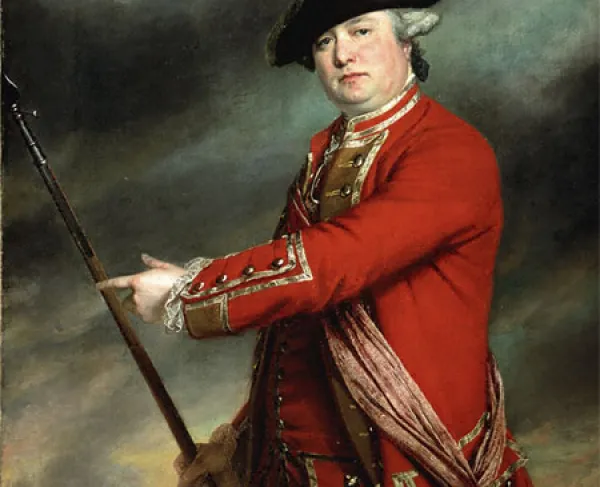Francis Smith

Born in 1723, Francis Smith joined the British army when he was eighteen, commissioning as a lieutenant in the Royal Fusiliers in 1741. A few years later Smith joined the 10th Regiment of Foot and promoted to captain in 1747. Smith had made the army his career and fought with the 10th Regiment fought in the Seven Years War. He was promoted to the rank of colonel in 1762.
In 1767, Smith took the regiment to North America. Tensions were rising over taxation and the role of the colonies in the British Empire. Commanding troops that settled in Boston, Massachusetts, Smith had a mixed reputation among other officers. Superior officers like General Thomas Gage respected Smith and trusted his leadership and judgment. Some subordinate officers, though, complained that Smith made poor decisions, acted slowly and his health limited his mobility.
General Gage and other British officers continued to try to seize gunpowder and weapons from the colonial militias. Previous attempts at other towns had met with mixed successes. According to some sources, Smith may have volunteered to go on a spy mission early in April 1775 and walk from Boston to Concord. Smith’s spy mission did not last long; he was recognized while still close to Boston and decided to turn back. However, others in the British network provided the needed information.
Gage ordered Smith to take command of the British force that would march to Concord, seize weapons and return to Boston. He had 21 companies of light infantry and grenadiers under his command, numbering approximately 700 men. Larger than a regiment, smaller than a brigade, this force had been assembled from different British units and lacked a chain of command, though Smith was in overall command of the expedition.
Following orders, the British force started moving in the night of April 18, 1775. When morning dawned on April 19, they were marching along the road to Concord and approaching the village of Lexington which was along the way. Smith had placed Major John Pitcairn and the Royal Marines in the advance of the column. Pitcairn confronted local militiamen at Lexington, and shots were fired. Smith reached the scene as British troops prepared to pursue the scattering militiamen. He ordered the British troops to reform. Overriding subordinates’ suggestions, Smith decided to continue to Concord and try to finish the mission. Before leaving Lexington, he sent messages back to General Gage in Boston, asking for reinforcements.
Smith and the British troops reached Concord. He ordered some troops to watch strategic points and sent others to search for the weapons. Another confrontation and exchange of volleys occurred at Old North Bridge. Smith recalled his soldiers and prepared to return to Boston. Along the road to Boston, hundreds of militiamen gathered and systematically ambushed the British column. Smith kept his troops marching quickly, worrying that if they stopped or slowed they would run out of ammunition and become standing targets. Smith held his troops together, even as many of his officers were killed or wounded and the troops marching formation became a general mass of soldiers.
West of Lexington and during “Parker’s Revenge”—an American ambush—Smith was shot in the thigh. Retreating to Lexington, the beleaguered British found reinforcements had arrived from Boston led by Hugh Percy. The British retreat continued under fire until they reached Charlestown. Smith’s expedition had failed, but he had held his troops together and shown courage during the retreat.
Francis Smith recovered from his wound, and on April 22, 1775, wrote a report for Gage, explaining his decisions and experiences in the march to Lexington and Concord. In time, some officers blamed Smith for the British troubles on April 19. However, Gage praised Smith’s leadership and decisions in his dispatches, and Smith was promoted to brigadier general.
Remaining in Boston—which was now surrounded by American militia and the newly-formed Continental Army—Smith failed to recognize the threats when early reports reached him that the Americans were placing artillery on Dorchester Heights. The cannons at Dorchester Heights ultimately forced the British to evacuate Boston, leaving that city to the American rebels.
During the New York Campaign, Smith commanded a brigade and failed to take an opportunity to cut off the Americans’ retreat. He fought at Long Island in 1776 and at Quaker Hill in 1778. The 10th Regiment of Foot returned to England later in 1778 and Smith went with them to oversee recruiting and training. He came back to American shores in 1779 and promoted to major general. Francis Smith’s military career extended beyond the British defeat in the American War for Independence and he became a lieutenant general in 1787. He died in 1791.
Francis Smith is most remembered for commanding the British troops who marched to Lexington and Concord on April 19, 1775 and exchanged the opening shots of the American Revolution. He was both praised and criticized for his role in that expedition. His life-long military service was recognized, though, and he continued to promote and serve the British army until the end of his life.
Related Battles
93
300





